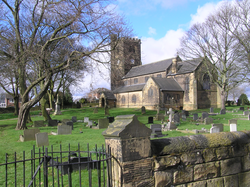
The Corpus of ROMANESQUE SCULPTURE in Britain & Ireland

St Michael (formerly)
Parish church
The village is arranged along the Escrick moraine and is probably at an early crossing place of the Derwent, where it was still tidal. The Woodhouses settlement, two miles east, existed in the later 12th century and a grange of Kirkham priory was established there.
The church is known for the pre-Conquest fragment of a cross shaft - one of several things found during alterations in 1927.
Outside, this appears to be a Gothic and later building, with a mixed fabric including rubble and an ashlar often of a golden yellow oolitic stone. The church has a nave and chancel of the same width, and this perhaps represents the plan of the first stone building. There are N and S aisles to the nave, a W tower of 14th and 15th centuries, S porch and 20th c. vestry to the N of the chancel. A clerestory was added to the nave in the 16th century. Restorations are recorded in 1841, 1846 and 1926-8.
A blocked round-headed arch in the chancel, opened up in 1927, is probably early 12th century. The three eastern bays of both arcades are from the late 12th century. The western bays later, added when the tower was begun, but the old responds seem to have been reused. The two arcades have much in common in their measurements, and in the use of lugs and foliage for sculptural detail.
Parish church
East Ardsley is now within the metropolitan area of Leeds, only 6 miles from the centre. The medieval church consisted of a W tower, nave and chancel (Ryder 1993, 149; Booth (1963) 1997, 14-15). The building was demolished in 1881. Before that Sir Stephen Glynne visited in April 1871 and described a church that 'had originally only chancel and nave, but a north aisle has been added [1781], in debased style, to the nave, and there is a poor modern west tower, of small size, and not worthy of being exactly described. The south wall of the nave is original and had a fine Norman doorway...three orders of arch mouldings, two with bold chevron work and one with lozenges. The shafts are gone but the capitals have square abaci and good sculpture.' (Butler 2007, 166). A new church was built to the N of the old site, reusing the 12thc doorway, but apparently no other elements of the earlier structure.
Parish church
W tower is Perpendicular, the rest rebuilt in 1862-3 using old materials, for example, in windows and chancel arch (Pevsner & Neave, 1995, 383). Cobble with stone dressings. The church largely follows its medieval plan, according to VCHER, VII, 255-9. It faces S onto open country, most of the village is to the N on a parallel road (B1244). There is a footpath that connects the church to this road near the second site in Catwick, which has reset twelfth-century pillars and capitals; see report for Catwick (Main Street).
Inside the rebuilt church is a reset figure cut into a flat panel, also a medieval stoup.
Parish church
Hubberholme is a village in Upper Wharfedale in the Yorkshire Dates. It is famous for connections with the playwright J.B. Priestley, who is buried at the church. This has a rectangular plan, with aisled nave and chancel in one, with squat W tower; this plan, with absence of a chancel arch, is common in the NW of the county and surrounding area. Later medieval windows to aisles. Restored 1863. The interior walls resemble the rough walls on the hills (field walls near the river are of rounded water-worn stones).
The S doorway and the S arcade have round arches but are unlikely to be Romanesque. Twelfth-century work is found in the tower and tower arch.
Parish church
Kirkby Malham is a village in North Yorkshire, 5 miles E of Settle. The church of St Michael is Grade 1 listed and is described by Pevsner as a 'handsome Pennine church, Perp. throughout' (Leach and Pevsner 2009, 369-70). It is essentially a late medieval church with aisled nave and chancel (without achancel arch); it retains a 12th-century font.




